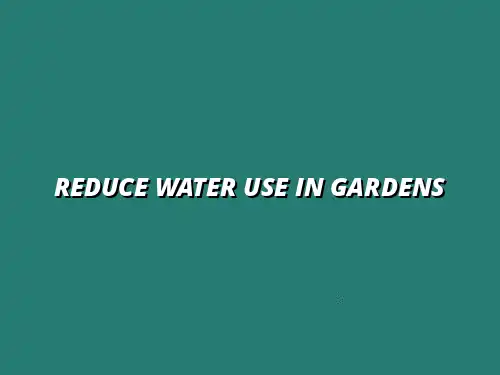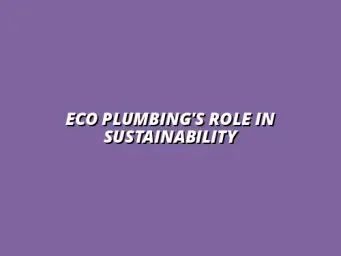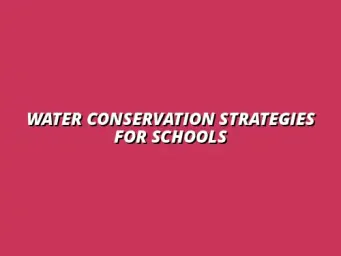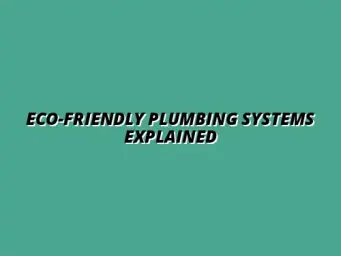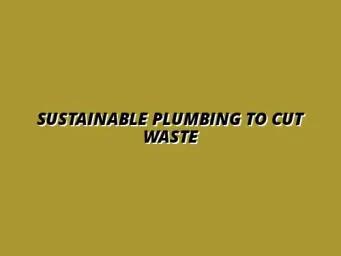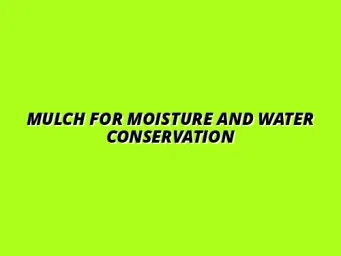Understanding the Importance of Water Conservation in Gardening
Water is a precious resource, especially in gardening. As we face increasing environmental challenges, it's crucial to understand how we can conserve water in our gardens. Not only does this help our plants thrive, but it also supports our local ecosystems and promotes sustainability. To learn more about simple ways to reduce water waste in your daily life, check out this helpful guide.
Many gardens use far more water than necessary, leading to waste and potential harm to nearby wildlife. By adopting water conservation techniques, we can create beautiful gardens while minimizing our environmental impact. Let's explore why water conservation is vital in gardening and how we can implement effective strategies!
The Environmental Impact of High Water Usage in Gardens
Excessive water usage in gardens can have significant effects on local ecosystems. When too much water is used, it can lead to runoff that washes away soil and nutrients, polluting nearby rivers and lakes. This not only harms aquatic life but also disrupts the natural balance of the ecosystem.
Additionally, high water consumption can lead to depletion of local freshwater supplies, especially in regions prone to drought. It's essential to recognize how our gardening habits affect the environment and to adopt practices that promote water conservation. For homeowners looking to upgrade their plumbing for better water efficiency, exploring eco-friendly plumbing options is a great first step.
- Runoff can carry fertilizers and pesticides into waterways.
- Excessive watering can harm plant roots and cause disease.
- Decreased groundwater levels can affect local wildlife habitats.
How Excess Water Affects Local Ecosystems
When we overwater our gardens, we can inadvertently create problems for local wildlife. Excess water can lead to soil erosion, which washes away essential nutrients that plants need to grow. This impacts the food chain, affecting not just plants but also the animals that depend on them.
Furthermore, standing water can create breeding grounds for pests and diseases, which not only harms our gardens but can also spread to other areas. Understanding these effects helps us appreciate the need for responsible water usage. Proper French drain installation can significantly improve drainage and prevent waterlogging in your garden.
Benefits of Sustainable Gardening Practices
By embracing sustainable gardening practices, we can significantly reduce water usage and promote a healthier environment. These practices not only conserve water but also enhance the resilience of our gardens, making them less susceptible to pests and disease. Here are some key benefits:
- Reduced reliance on chemical fertilizers and pesticides.
- Improved soil structure and health.
- Enhanced biodiversity, attracting beneficial insects and wildlife.
Overall, sustainable gardening practices help us create a thriving garden environment that respects our natural resources. Regular plumbing maintenance in your home can also contribute to overall water conservation.
Effective Strategies to Reduce Water Consumption in the Garden
As gardeners, we have numerous opportunities to improve water efficiency in our gardening practices. The good news is that many effective strategies can help us save water while still enjoying vibrant and healthy plants. From choosing the right irrigation techniques to selecting drought-tolerant plants, every little change can make a significant difference.
Let’s delve into some of the most effective strategies to help reduce water consumption in our gardens!
Implementing Efficient Irrigation Techniques
One of the best ways to save water is by using efficient irrigation techniques. Instead of traditional methods that waste water, we can utilize systems designed to deliver water directly to the roots of plants. This not only conserves water but also improves the health of our plants.
Two popular methods are drip irrigation and soaker hoses. Both options allow for targeted watering, ensuring plants receive the moisture they need without excess runoff. Remember to maintain your water heater efficiently to minimize water waste within your home as well.
- Drip irrigation systems can be customized for different plants.
- Soaker hoses deliver water slowly and evenly to the soil.
- Both methods can significantly reduce water usage compared to overhead watering.
Exploring Drip Irrigation Systems
Drip irrigation systems are highly effective for reducing water waste in gardens. These systems use tubes with emitters that release water directly at the base of each plant. This targeted approach not only minimizes evaporation but also encourages deep root growth.
Furthermore, drip irrigation can be set up on timers, ensuring plants receive consistent watering without over-saturation. By implementing a drip system, you can enjoy a healthy garden while conserving this valuable resource.
The Advantages of Soaker Hoses
Soaker hoses are another fantastic option for efficient watering. These porous hoses allow water to seep directly into the soil, providing moisture where it's needed most. This method helps reduce evaporation and runoff, making it a water-saving choice for gardeners.
Soaker hoses are easy to install and can cover large areas with minimal effort. By using these hoses, you can maintain a lush garden while being mindful of water consumption! For further water saving tips for your home, check out this comprehensive guide.
Choosing Drought-Tolerant Plants
Incorporating drought-tolerant plants into your garden can significantly reduce water use. These plants are adapted to thrive in low-water conditions, making them perfect choices for sustainable gardening. Not only do they require less water, but they also flourish in various conditions!
By selecting the right plants, you can create a beautiful garden that is both water-efficient and environmentally friendly. Let’s look at some key benefits and popular varieties of drought-resistant plants.
Benefits of Native Plants for Water Efficiency
Using native plants in your garden is an excellent way to conserve water. Native plants are adapted to the local climate and soil conditions, which means they often require less irrigation once established. They also provide crucial habitat for local wildlife, enhancing biodiversity.
By incorporating native plants, you not only help your garden thrive but also support the local ecosystem. This approach is a win-win for both gardeners and the environment!
- Native plants typically require less maintenance.
- They are better suited for local pests and diseases.
- Native plants enhance the natural beauty of your area.
Popular Drought-Resistant Plant Varieties
There are many stunning drought-resistant plants to choose from. Some popular varieties include:
- Lavender: Aromatic and beautiful, it thrives in dry conditions.
- Succulents: These come in various shapes and colors, perfect for low-water gardens.
- Agave: A striking plant that requires minimal watering.
- Yarrow: A hardy perennial that attracts pollinators.
By selecting these plants, you can create vibrant spaces that require minimal water, contributing to a more sustainable garden!
Optimizing Soil Health for Better Water Retention
Improving soil health is a key strategy in reducing water consumption. Healthy soil enhances water retention, allowing plants to access moisture without frequent watering. Understanding soil composition and incorporating organic matter can lead to more resilient gardens!
By focusing on soil health, we can create a foundation that supports optimal plant growth while conserving water resources. Let's dive into the importance of soil composition and organic matter. If you're experiencing plumbing issues, consider contacting a local plumber for assistance.
Understanding Soil Composition and its Role
Soil is made up of various components, including sand, silt, clay, and organic matter. Each component plays a role in water retention and drainage. For example, sandy soils drain quickly, leading to rapid evaporation, while clay retains water but can become compacted.
A balanced soil composition supports plant health and helps retain moisture. Amending your soil with organic materials can improve its structure, making it better at holding water. This is especially beneficial in gardens aiming for water efficiency.
The Importance of Organic Matter in Soil
Organic matter, like compost and mulch, is essential for healthy soil. It not only provides nutrients for plants but also enhances soil structure and water retention. When organic matter breaks down, it creates spaces in the soil that hold moisture.
By regularly adding organic matter to your garden, you can improve its water-holding capacity, reducing the need for frequent watering. This simple practice can lead to a flourishing garden!
Utilizing Rainwater Harvesting Systems
Rainwater harvesting is an excellent way to collect and use natural water sources. By capturing rainwater from roofs and other surfaces, you can create a sustainable water source for your garden. This not only conserves municipal water but also reduces stormwater runoff!
Implementing a rainwater harvesting system is relatively simple and can significantly benefit your garden. Let's discuss effective methods for collecting rainwater and the types of rain barrels available.
Methods for Collecting Rainwater Effectively
There are several effective methods for collecting rainwater, including:
- **Installing rain barrels**: These are placed under downspouts to catch runoff.
- **Building a rain garden**: This allows water to pool, promoting absorption into the soil.
- **Utilizing cisterns**: Large tanks can store significant amounts of rainwater for later use.
Each method offers unique benefits, and you can choose one that suits your gardening style and needs!
Types of Rain Barrels and Their Uses
Rain barrels come in various shapes and sizes, making them versatile tools for water conservation. Some common types include:
- Basic rain barrels: Simple, affordable, and easy to install.
- Decorative rain barrels: These blend with garden aesthetics while serving a practical purpose.
- Rain barrels with filters: These prevent debris from entering the barrel and help maintain water quality.
By using rain barrels, you can harness nature's water and give your garden the hydration it needs without relying on municipal sources.
Implementing Mulching Techniques
Mulching is an effective technique for conserving moisture in the garden. By covering the soil with a layer of material, we can reduce evaporation and keep the soil temperature stable. This practice not only saves water but also benefits plant health!
There are various types of mulch, and choosing the right one can enhance your garden's water efficiency. Let's explore the benefits of organic versus inorganic mulch.
Benefits of Organic vs. Inorganic Mulch
Both organic and inorganic mulches serve important functions in water conservation. Organic mulch, like wood chips or straw, adds nutrients to the soil as it decomposes. This enriches the soil while helping to retain moisture.
Inorganic mulch, such as gravel or plastic, can effectively block weeds and reduce evaporation. Each type has its advantages, and selecting the right mulch for your garden can lead to healthier plants and less water use!
- Organic mulch improves soil fertility.
- Inorganic mulch can last longer and requires less maintenance.
- Both types help keep soil cool and moist.
How Mulching Reduces Evaporation
Mulching helps to reduce evaporation by creating a protective barrier over the soil. This barrier minimizes the sun's direct impact on the soil, keeping it cooler and retaining moisture. As a result, plants can access water longer without the need for frequent watering.
In addition to water conservation, mulching also suppresses weeds, which compete for moisture and nutrients. By implementing mulching techniques, you can create a vibrant garden while saving water!
Smart Watering Practices for Garden Maintenance
Adopting smart watering practices is crucial for maintaining a healthy garden while conserving water. Knowing when and how to water can make a significant difference in water usage and plant health. Let's discuss the best times to water and how to adjust frequency based on the season!
By being intentional about our watering habits, we can keep our gardens thriving while using water efficiently!
Timing: When is the Best Time to Water?
The timing of watering can greatly influence how much water your garden needs. Early morning is often considered the best time to water, as temperatures are cooler and evaporation rates are lower. This allows plants to absorb moisture before the heat of the day!
Evening watering can also be effective, but be cautious of potential fungal diseases from damp foliage. By timing your watering effectively, you can reduce water waste and promote better plant health.
Adjusting Watering Frequency Seasonally
It's essential to adjust your watering frequency based on the seasons. During hot summer months, plants may require more frequent watering due to higher evaporation rates. In contrast, cooler months may necessitate less frequent watering as soil moisture levels tend to remain stable.
By closely monitoring your plants and soil moisture levels, you can tailor your watering practices to ensure optimal growth while conserving water. This adaptability leads to a more resilient and sustainable garden!
Creating a Water-Wise Garden Layout
Planning a water-wise garden layout can have a lasting impact on water conservation. By strategically placing plants and creating contours, we can optimize water usage and ensure that plants receive sufficient moisture. Effective garden design is a crucial aspect of sustainable gardening!
Let’s explore how to plan plant placement and implement contour gardening for better water management.
Planning Plant Placement for Optimal Water Usage
Plant placement is vital in creating a water-efficient garden. Grouping plants with similar water needs together can help ensure that each plant receives adequate moisture without waste. Additionally, placing drought-tolerant plants in sunniest areas will minimize their water requirements.
By designing your garden layout with water efficiency in mind, you can create a thriving and sustainable environment for your plants.
- Group plants according to their water needs.
- Position taller plants to provide shade to shorter ones.
- Utilize containers for plants with higher water needs.
Implementing Contour Gardening for Better Drainage
Contour gardening involves planting on the natural contours of the land, which can enhance drainage and retain moisture. This method directs water flow and prevents erosion, allowing plants to access water more effectively. Additionally, it reduces runoff, promoting water conservation.
By implementing contour gardening techniques, you can create a more sustainable garden that thrives in harmony with the environment!
Addressing Common Questions About Water Usage in Gardens
Many gardeners have questions about water usage and how to optimize it for plant health. Understanding the specific needs of your garden can lead to better practices and conservation methods. Let's dive into some common queries and their answers to help you become more informed about your watering routines.
How Much Water Does a Garden Actually Need?
The amount of water a garden needs can vary widely based on several factors. These include the types of plants, soil conditions, and local climate. By grasping these elements, you can make more effective decisions about how much water to provide.
- Plant Type: Different plants have unique water requirements.
- Soil Type: Sandy soils drain quickly, while clay soils retain water longer.
- Weather Conditions: Hot and dry weather increases water needs.
Factors Influencing Water Requirements
Various factors play a role in determining how much water your garden should receive. Some key elements include:
- Plant Growth Stage: Young plants often need more water than mature ones.
- Season: During summer, gardens may require up to twice as much water as in spring or fall.
- Mulching: Mulch can help retain moisture, reducing the need for extra watering.
Understanding Evapotranspiration Rates
Evapotranspiration is the process by which water evaporates from soil and transpires from plants. Knowing these rates can help you fine-tune your watering schedule. Typically, a garden may require 1 to 2 inches of water per week, depending on climatic conditions and plant types.
Keep in mind that monitoring local weather conditions can help you adjust your watering practices accordingly. Checking local evapotranspiration data can be a useful tool in maintaining optimal watering habits!
What Are the Signs of Overwatering in Plants?
Overwatering can be just as harmful as underwatering. Knowing how to recognize the signs is crucial for keeping your plants healthy. Common symptoms include yellowing leaves, wilting, and root rot.
- Yellowing Leaves: Often indicates too much moisture.
- Wilting Despite Wet Soil: Suggests root problems.
- Foul Smell from Soil: Indicates rotting roots and bad drainage.
Identifying Symptoms and Solutions
Identifying the symptoms of overwatering can help you take quick action. If you notice any of the signs mentioned above, consider these solutions:
- Check Drainage: Ensure pots or garden beds have proper drainage.
- Adjust Watering Schedule: Water less frequently, allowing soil to dry.
- Improve Soil Aeration: Mix in organic matter to enhance soil structure.
Maintaining the Right Balance for Plant Health
It's essential to strike a balance when it comes to watering. Overwatering can lead to health issues for your plants, while underwatering can cause stress. Pay attention to your plants and their environment to find the sweet spot of moisture that best supports their growth.
Future Trends in Water Conservation for Gardening
As we look to the future, technology is playing a more significant role in water conservation for gardening. New innovations are helping gardeners use water more efficiently and effectively. Let's explore some of these trends!
The Role of Technology in Water Management
Technology is transforming the way we manage water in our gardens. Smart irrigation systems, for instance, can optimize water use based on real-time conditions. This advancement not only conserves water but also ensures plants receive adequate moisture.
- Soil Moisture Sensors: Monitor moisture levels and adjust watering automatically.
- Weather-Based Controllers: Adjust watering schedules based on local weather forecasts.
- Remote Monitoring: Allows you to check and manage watering from your smartphone.
Smart Irrigation Systems and Their Benefits
Smart irrigation systems can significantly reduce water waste while promoting healthy plants. They often include features like:
- Automated Scheduling: Set watering times and durations based on plant needs.
- Leak Detection: Monitor for leaks and prevent water loss.
- Data Analysis: Track and analyze water usage over time.
Using Apps for Water Tracking and Management
Several apps are now available to help gardeners track their water use and manage irrigation. These apps can assist in monitoring moisture levels and setting reminders for watering. Utilizing technology can aid in making informed decisions that align with water conservation goals!
Building a Community Around Sustainable Gardening
Creating a community focused on sustainable gardening practices can amplify water conservation efforts. Sharing resources and knowledge among fellow gardeners promotes a collective responsibility toward the environment. Here are ways you can get involved!
- Join Local Gardening Groups: Connect with others who share your passion for conservation.
- Host Workshops: Share your knowledge about effective water usage strategies.
- Participate in Online Forums: Exchange ideas and seek advice on sustainable practices.
Sharing Resources and Knowledge Locally
By sharing resources such as rain barrels or compost bins, we can strengthen our communities. Collaborating on projects like community gardens can also help in spreading awareness about water-efficient gardening. It’s a win-win for everyone involved!
Participating in Community Gardening Initiatives
Engaging in community gardening initiatives is a great way to learn and apply sustainable practices. These initiatives not only provide hands-on experience but also help foster relationships with fellow gardeners. Together, we can work towards a more water-wise future!
Summarizing Key Takeaways for Water Conservation in Gardening
As we wrap up our discussion on water conservation in gardening, it’s essential to remember the key techniques we've covered. By implementing these methods, you can create a thriving garden while conserving water effectively. Let’s recap!
Recapping Effective Techniques for Reducing Water Usage
Some effective techniques for reducing water usage in your garden include:
- Efficient Irrigation: Use smart systems and timers.
- Drought-Tolerant Plants: Choose native and resilient species.
- Mulching: Help retain soil moisture.
Encouraging a Sustainable Gardening Mindset
Encouraging a sustainable gardening mindset can foster a culture of conservation. By promoting awareness of water-saving strategies, we can inspire others to do the same. Together, we can all make a positive impact!
Next Steps for Implementing Water-Saving Strategies
Now that you have the knowledge, it's time to take action! Start by assessing your current watering practices and identifying areas for improvement. Small changes can lead to significant savings, benefiting both your garden and the environment!

